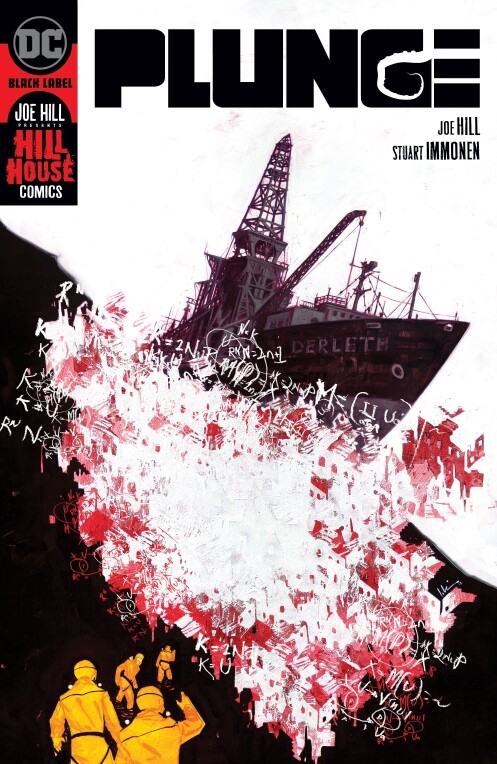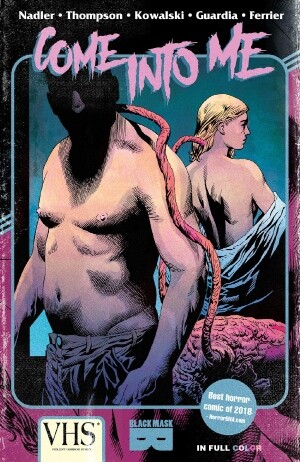Comic books in the science fiction and horror genres have long sat adjacent to one another, but occasionally they cross paths and the results are spectacularly frightening. The best sci-fi horror comics have stories full of suspense and heavy with dread, as well as artwork that shocks and unnerves. In fact, comics and graphic novels are a great medium for the horror genre. The narrative format often keeps the dialogue and description to a minimum, increasing the suspense and allowing the images to speak for themselves. And, likewise, the artwork expertly compliments the prose, whether it’s using muted shades and darkened corridors to augment the mood or vivid colors and heaps of blood to highlight the horror. The writers at Puzzle Box Horror are obsessed with comics, and we’re very excited to share some of the best sci-fi horror comics on the market!
The Best Sci-Fi Horror Comics
Plunge (2020)
First on our list of best sci-fi horror comics is Plunge. A drilling vessel, the Derleth, that disappeared forty years ago in the Arctic Circle suddenly begins sending out distress signals from the Bering Strait. Wanting to investigate further, an oil company hires a salvage team and a marine biologist to go explore the ghost ship. Their mission is to recover the bodies and find out exactly what happened to the ship. The expedition quickly goes awry when they discover the crew isn’t exactly dead, though they aren’t exactly alive either. This six-issue miniseries is gory, surreal, and a wonderful homage to eighties horror.
Plunge (Image Comics) is written by Joe Hill with art by Stuart Immonen.
Come Into Me (2019)
The story opens on a failed demonstration of InBeing, the process by which ropy entrails connect two different people by ports in the back of their heads and allows their minds to form a “synaptic connection”. Sebastian, the creator and scientist behind the technology, is quickly running out of money and desperate to find an investor. Enter Becky, a mysterious and seemingly desperate young lady who convinces Sebastian to bond their minds with InBeing, using his body as host. It’s strange for Becky, seeing the world through someone else’s body and forming a telepathic-like connection with another. If only she had been upfront with Sebastian about her past. As their minds are conjoined and their memories/experiences blend together, the host realizes he failed to anticipate just exactly what could go wrong…and that, like in our online lives, shared data is open to manipulation and exploitation.
Come Into Me (Black Mask Comics) is written by Zac Thompson and Lonnie Nadler, illustrated by Piotr Kowalski, and colored by Niko Guardia.
Destroyer (2018)
Though lighter on the horror than the other entries in this list, Destroyer is still an intriguing take on the creature at the center of Mary Shelley’s classic sci-fi story Frankenstein. In this story the monster has survived into present day America, but he has lost his emotional side and empathic nature. Instead he has become the Destroyer, bent on wiping mankind from the face of the earth. In his quest for vengeance he ends up partnering with Dr. Baker, the last descendent of the Frankenstein family who has recently lost her son at the hands of the police. Also caught up in all of this are two scientists, Byron and Percy, who find themselves desperately trying to protect humanity. It’s a story that is raw, powerful, and not afraid to shine a light on heavy socio-political topics. Sometimes the line between thriller and horror is slim but this one still made our list of best sci-fi horror comics as it fits the bill.
Destroyer (Boom Studios) is written by Victor Lavalle and illustrated by Dietrich Smith, with colors by Joana Lafuente and letters by Jim Campbell.
Nameless (2016)
A group of billionaires have hired occult hustler “Nameless” in a desperate bid to save the planet. An enormous asteroid they’re calling Xibalba is hurtling on a direct course for earth, bearing a strange symbol on its side and a vengeful extra-dimensional god in its core. While trying to stop the death rock, Nameless and his team accidentally set loose the wrathful being and things go from bad to inconceivably worse. That’s the brief synopsis, but this six-part miniseries deals with so much more. Secret experiments, the downfall of civilization, lost planets, epic cosmic wars, a doomsday asteroid, and soul-destroying truths are all par for the course here. This sci-fi horror comic also has a strong cosmic horror vein running through it, featuring terrifying Lovecraftian beings and an overwhelming atmosphere of dread. What could be better in sci-fi horror than a touch of existential dread?
Nameless (Image Comics) is written by Grant Morrison and illustrated by Chris Burnham.
The Disciples (2016)
This sci-fi horror comic is Set in a bleak dystopian future where the solar system has been colonized by the rich upper class, The Disciples is about a girl who has gone missing and the bounty hunters who have been hired to find her. These hunters follow the trail to Jupiter’s largest moon Ganymede, where they discover a group of cultists who have awakened a horrifying force. Turns out the girl is the daughter of a Senator who has joined the cult, and things are about to get a whole lot worse for these well-intentioned investigators. Taunt and terrifying, the comic is reminiscent of the video game Dead Space but with more extraterrestrial ghosts.
The Disciples (Black Mask Studios) is written by Steve Niles and illustrated by Chris Mitten, with colors by Jay Fotos and letters by Thomas Mauer.
Spread (2015)
In this post-apocalyptic sci-fi horror comic, a strange viral infection called “the Spread” has devastated the land and devoured its inhabitants. While most of the world lies in ruin, there are pockets of humanity struggling to survive in quarantine zones. In one of these zones a man named No happens upon a baby named Hope who can undo the virus with a touch of her hand. Insane creature designs and an interesting cast of characters help flesh out this dark and suspenseful tale of survival. The unholy baby of The Thing and Mad Max bathed in buckets of blood, Spread is full of extreme gore, tentacles, and body horror fun.
Spread (Image Comics) is written by Justin Jordan with art by Kyle Strahm.
Caliban (2015)
In the future hyperspace travel has been invented, allowing humans to explore the furthest reaches of outer space. For all their searching no signs of life have been uncovered, but they have begun to harvest all the valuable resources the universe has to offer. At first it’s just a regular mission out in deep space for the crew of the mining ship Caliban. Everything is going according to plan, until they happen upon a strange alien ship. It would appear the unusual vessel was waiting for them, and what was once a routine trip quickly turns to nightmare. A vicious, hulking something is stalking the corridors, separating the crew and taking them one by one. It’s a tense and chilling thriller reminiscent of Alien, full of shocking moments and terrific artwork.
Caliban (Avatar Press) is written by Garth Ennis with art by Facundo Percio.
The Wake (2014)
The Department of Homeland Security has identified an unnerving new threat, and so they reach out to Lee Archer, a marine biologist, for help. Though she initially declines, the government overrides her decision and sends her deep beneath the sea in the Arctic Circle. There’s an underwater oil rig in that part of the ocean where a group of scientists have made an unbelievable discovery. Part multi-generational thriller and part creature feature, The Wake is a ten-issue miniseries that manages to combine tense horror, beautifully bold artwork, and scientific questions on life and the human condition.
The Wake (DC Comics) is written by Scott Snyder with art by Sean Murphy.
Revival (2012)
The dead have come back to life in rural Wisconsin. In the particular town where our story is set, the CDC has quarantined the area and sent in experts to help out. Revival, labeled as “farm noir,” is interesting because of its unique take on the genre. Yes, it’s a zombie tale full of scares, violence, religious zealots, and government busybodies. But a lot of the series also focuses on a brutal murder and the detective who is trying to solve the crime. Officer Dana Cypress has her hands full dealing with the media, the government, and a full-scale zombie invasion while also investigating a case where anyone, dead or alive, could be a suspect.
Revival is a staff favorite for best sci fi horror comics.
Revival (Image Comics) is written by Tim Seeley, illustrated by Mike Norton, and colored by Mark Englert.

Ben’s love for horror began at a young age when he devoured books like the Goosebumps series and the various scary stories of Alvin Schwartz. Growing up he spent an unholy amount of time binge watching horror films and staying up till the early hours of the morning playing games like Resident Evil and Silent Hill. Since then his love for the genre has only increased, expanding to include all manner of subgenres and mediums. He firmly believes in the power of horror to create an imaginative space for exploring our connection to each other and the universe, but he also appreciates the pure entertainment of B movies and splatterpunk fiction.
Nowadays you can find Ben hustling his skills as a freelance writer and editor. When he’s not building his portfolio or spending time with his wife and two kids, he’s immersing himself in his reading and writing. Though he loves horror in all forms, he has a particular penchant for indie authors and publishers. He is a proud supporter of the horror community and spends much of his free time reviewing and promoting the books/comics you need to be reading right now!


